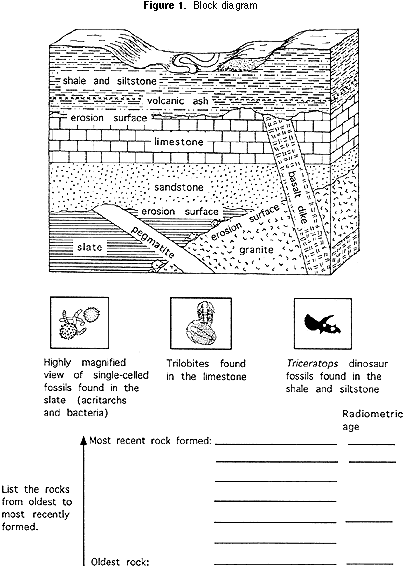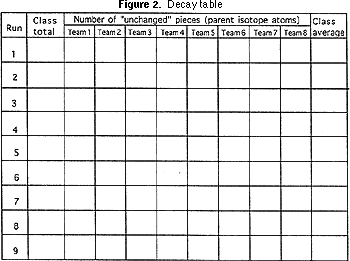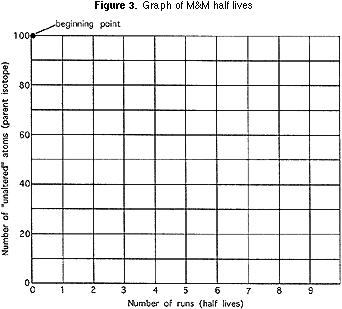DETERMINING AGE
OF ROCKS AND FOSSILS
FRANK K. MCKINNEY
THE AGE of fossils intrigues almost everyone. Students not only want to know how old a
fossil is, but they want to know how that age was determined. Some very straightforward
principles are used to determine the age of fossils. Students should be able to understand the
principles and have that as a background so that age determinations by paleontologists and
geologists don't seem like black magic.
There are two types of age determinations. Geologists in the late 18th and early 19th century
studied rock layers and the fossils in them to determine relative age. William Smith was one
of the most important scientists from this time who helped to develop knowledge of the
succession of different fossils by studying their distribution through the sequence of
sedimentary rocks in southern England. It wasn't until well into the 20th century that enough
information had accumulated about the rate of radioactive decay that the age of rocks and
fossils in number of years could be determined through radiometric age dating.
This activity on determining age of rocks and fossils is intended for 8th or 9th grade students.
It is estimated to require four hours of class time, including approximately one hour total of
occasional instruction and explanation from the teacher and two hours of group (team) and
individual activities by the students, plus one hour of discussion among students within the
working groups.
Explore this link for additional information on the topics covered in this lesson:
PURPOSE AND OBJECTIVES
This activity will help students to have a better understanding of the basic principles used to
determine the age of rocks and fossils. This activity consists of several parts. Objectives of
this activity are:
1) To have students determine relative age of a geologically complex area.
2) To familiarize students with the concept of half-life in radioactive decay.
3) To have students see that individual runs of statistical processes are less predictable than
the average of many runs (or that runs with relatively small numbers involved are less
dependable than runs with many numbers).
4) To demonstrate how the rate of radioactive decay and the buildup of the resulting decay
product is used in radiometric dating of rocks.
5) To use radiometric dating and the principles of determining relative age to show how ages
of rocks and fossils can be narrowed even if they cannot be dated radiometrically.
 Return to top Return to top
MATERIALS REQUIRED FOR EACH GROUP
1) Block diagram (Figure 1).
2) Large cup or other container in which M & M's can be shaken.
3) 100 M & M's
4) Graph paper (Figure 2).
5) Watch or clock that keeps time to seconds. (A single watch or clock for the entire class will
do.)
6) Piece of paper marked TIME and indicating either 2, 4, 6, 8, or 10 minutes.
7) 128 small cards or buttons that may be cut from cardboard or construction paper,
preferably with a different color on opposite sides, each marked with "U-235" all on one
colored side and "Pb-207" on the opposite side that has some contrasting color.


 Return to top Return to top
PART 1: DETERMINING RELATIVE AGE OF ROCKS
Each team of 3 to 5 students should discuss together how to determine the relative age of
each of the rock units in the block diagram (Figure 1). After students have decided how to
establish the relative age of each rock unit, they should list them under the block, from most
recent at the top of the list to oldest at the bottom.
The teacher should tell the students that there are two basic principles used by geologists to
determine the sequence of ages of rocks. They are:
Principle of superposition: Younger sedimentary rocks are deposited on top of older
sedimentary rocks.
Principle of cross-cutting relations: Any geologic feature is younger than anything
else that it cuts across.
PART 2: RADIOMETRIC AGE-DATING
Some elements have forms (called isotopes) with unstable atomic nuclei that have
a tendency to change, or decay. For example, U-235 is an unstable isotope of
uranium that has 92 protons and 143 neutrons in the nucl eus of each atom. Through
a series of changes within the nucleus, it emits several particles, ending up
with 82 protons and 125 neutrons. This is a stable condition, and there are
no more changes in the atomic nucleus. A nucleus with that number of protons
is called lead (chemical symbol Pb). The protons (82) and neutrons (125) total
207. This particular form (isotope) of lead is called Pb-207. U-235 is the parent
isotope of Pb-207, which is the daughter isotope.
Many rocks contain small amounts of unstable isotopes and the daughter isotopes into which
they decay. Where the amounts of parent and daughter isotopes can be accurately measured,
the ratio can be used to determine how old the rock is, as shown in the following activities.
Part 2a Activity — At any moment there is a small chance that each of the nuclei of
U-235 will suddenly decay. That chance of decay is very small, but it is always present and it
never changes. In other words, the nuclei do not "wear out" or get "tired". If the nucleus has
not yet decayed, there is always that same, slight chance that it will change in the near future.
Atomic nuclei are held together by an attraction between the large nuclear particles (protons
and neutrons) that is known as the "strong nuclear force", which must exceed the electrostatic
repulsion between the protons within the nucleus. In general, with the exception of the single
proton that constitutes the nucleus of the most abundant isotope of hydrogen, the number of
neutrons must at least equal the number of protons in an atomic nucleus, because electrostatic
repulsion prohibits denser packing of protons. But if there are too many neutrons, the nucleus
is potentially unstable and decay may be triggered. This happens at any time when addition of
the fleeting "weak nuclear force" to the ever-present electrostatic repulsion exceeds the
binding energy required to hold the nucleus together.
Very careful measurements in laboratories, made on VERY LARGE numbers of U-235
atoms, have shown that each of the atoms has a 50:50 chance of decaying during about
704,000,000 years. In other words, during 704 million years, half the U-235 atoms that
existed at the beginning of that time will decay to Pb-207. This is known as the half life of U-
235. Many elements have some isotopes that are unstable, essentially because they have too
many neutrons to be balanced by the number of protons in the nucleus. Each of these unstable
isotopes has its own characteristic half life. Some half lives are several billion years long, and
others are as short as a ten-thousandth of a second.
 Return to top Return to top
A tasty way for students to understand about half life is to give each team 100 pieces of
"regular" M & M candy. On a piece of notebook paper, each piece should be placed with the
printed M facing down. This represents the parent isotope. The candy should be poured into a
container large enough for them to bounce around freely, it should be shaken thoroughly,
then poured back onto the paper so that it is spread out instead of making a pile. This first
time of shaking represents one half life, and all those pieces of candy that have the printed M
facing up represent a change to the daughter isotope. The team should pick up and set aside
ONLY those pieces of candy that have the M facing up. Then, count the number of pieces of
candy left with the M facing down. These are the parent isotope that did not change during
the first half life.
The teacher should have each team report how many pieces of parent isotope remain, and the
first row of the decay table (Figure 2) should be filled in and the average number calculated.
The same procedure of shaking, counting the "survivors", and filling in the next row on the
decay table should be done seven or eight more times. Each time represents a half life.
After the results of the final "half life" of the M& M are collected, the candies are no longer
needed.
Each team should plot on a graph (Figure 3) the number of pieces of candy remaining after
each of their "shakes" and connect each successive point on the graph with a light line. On
the same graph each team should plot the AVERAGE VALUES for the class as a whole and
connect that by a heavier line. AND, on the same graph, each group should plot points where,
after each "shake" the starting number is divided by exactly two and connect these points by a
differently colored line. (This line begins at 100; the next point is 100/ 2, or 50; the next point
is 50/2, or 25; and so on.)
 After the graphs are plotted, the teacher should guide the class into thinking about:
After the graphs are plotted, the teacher should guide the class into thinking about:
1) Why didn't each group get the same results?
2) Which follows the mathematically calculated line better? Is it the single group's results, or
is it the line based on the class average? Why?
3) Did students have an easier time guessing (predicting) the results when there were a lot of
pieces of candy in the cup, or when there were very few? Why?
U-235 is found in most igneous rocks. Unless the rock is heated to a very high temperature,
both the U-235 and its daughter Pb-207 remain in the rock. A geologist can compare the
proportion of U-235 atoms to Pb-207 produced from it and determine the age of the rock. The
next part of this exercise shows how this is done.
 Return to top Return to top
Part 2b Activity — Each team receives 128 flat pieces, with U-235 written on one
side and Pb-207 written on the other side. Each team is given a piece of paper marked TIME,
on which is written either 2, 4, 6, 8, or 10 minutes.
The team should place each marked piece so that "U-235" is showing. This represents
Uranium-235, which emits a series of particles from the nucleus as it decays to Lead-207 (Pb-
207). When each team is ready with the 128 pieces all showing "U-235", a timed two-minute
interval should start. During that time each team turns over half of the U-235 pieces so that
they now show Pb-207. This represents one "half-life" of U-235, which is the time for half
the nuclei to change from the parent U-235 to the daughter Pb-207.
A new two-minute interval begins. During this time the team should turn over HALF OF
THE U-235 THAT WAS LEFT AFTER THE FIRST INTERVAL OF TIME. Continue
through a total of 4 to 5 timed intervals.
However, each team should STOP turning over pieces at the time marked on their TIME
papers. That is, each team should stop according to their TIME paper at the end of the first
timed interval (2 minutes), or at the end of the second timed interval (4 minutes), and so on.
After all the timed intervals have occurred, teams should exchange places with one another as
instructed by the teacher. The task now for each team is to determine how many timed
intervals (that is, how many half-lives) the set of pieces they are looking at has experienced.
The half life of U-235 is 704 million years. Both the team that turned over a set of pieces and
the second team that examined the set should determine how many million years are
represented by the proportion of U-235 and Pb-207 present, compare notes, and haggle about
any differences that they got. (Right, each team must determine the number of millions of
years represented by the set that they themselves turned over, PLUS the number of millions
of years represented by the set that another team turned over.)
PART 3: PUTTING DATES ON ROCKS AND FOSSILS
For the block diagram (Figure 1) at the beginning of this exercise, the ratio of U-235:Pb-207
atoms in the pegmatite is 1:1, and their ratio in the granite is 1:3. Using the same reasoning
about proportions as in Part 2b above, students can determine how old the pegmatite and the
granite are. They should write the ages of the pegmatite and granite beside the names of the
rocks in the list below the block diagram (Figure 1).
By plotting the half life on a type of scale known as a logarithmic scale, the curved line like
that for the M & MTM activity can be straightened out, as you can see in the graph in Figure
4. This makes the curve more useful, because it is easier to plot it more accurately. That is
especially helpful for ratios of parent isotope to daughter isotope that represent less than one
half life. For the block diagram (Figure 1), if a geochemical laboratory determines that the
volcanic ash that is in the siltstone has a ratio of U-235:Pb-207 of 47:3 (94% of the original
U-235 remains), this means that the ash is 70 million years old (see Figure 4). If the ratio in
the basalt is 7:3 (70% of the original U-235 remains), then the basalt is 350 million years old
(again, see Figure 4). Students should write the age of the volcanic ash beside the shale,
siltstone and basalt on the list below the block diagram.
 Return to top Return to top

QUESTIONS FOR DISCUSSION
1) Based on the available radiometric ages, can you determine the possible age of the rock
unit that has acritarchs and bacteria? What is it? Why can't you say exactly what the age of
the rock is?
2) Can you determine the possible age of the rock unit that has trilobites? What is it? Why
can't you say exactly what the age of the rock is?
3) What is the age of the rock that contains the Triceratops fossils? Why can you be more
precise about the age of this rock than you could about the ages of the rock that has the
trilobites and the rock that contains acritarchs and bacteria?
Note for teachers: Based on cross-cutting relationships, it was established that the
pegmatite is younger than the slate and that the slate is younger than the granite. Therefore,
the slate that contains the acritarch and bacteria is between 704 million years and 1408
million years old, because the pegmatite is 704 million years old and the granite is 1408
million years old. The slate itself cannot be radiometrically dated, so can only be bracketed
between the ages of the granite and the pegmatite.
The trilobite-bearing limestone overlies the quartz sandstone, which cross-cuts the pegmatite,
and the basalt cuts through the limestone. Therefore the trilobites and the rock that contains
them must be younger than 704 million years (the age of the pegmatite) and older than 350
million years (the age of the basalt). The limestone itself cannot be radiometrically dated, so
can only be bracketed between the ages of the granite and the pegmatite.
The Triceratops dinosaur fossils are approximately 70 million years old, because they are
found in shale and siltstone that contain volcanic ash radiometrically dated at 70 million
years. Any Triceratops found below the volcanic ash may be a little older than 70 million
years, and any found above may be a little younger than 70 million years. The age of the
Triceratops can be determined more closely than that of the acritarchs and bacteria and that of
the trilobites because the rock unit that contains the Triceratops can itself be radiometrically
dated, whereas that of the other fossils could not.

|